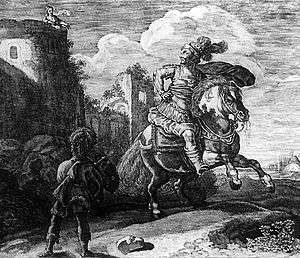Scylla (princess)
In Greek mythology, Scylla [1] (/ˈsɪlə/ SIL-ə; Greek: Σκύλλα, pronounced [skýl̚la], Skylla) is a princess of Megara.

Mythology
As the story goes, Scylla was the daughter of Nisus (Nisos) the King of Megara, who possessed a single lock of purple hair which granted him and the city invincibility. When Minos, the King of Crete, invaded Nisus's kingdom, Scylla saw him from the city's battlements and fell in love with him. In order to win Minos's heart, she decided that she would grant him victory in battle by removing the lock from her father's head and presented it to Minos. Disgusted with her lack of filial devotion, he left Megara immediately. Scylla did not give up easily and started swimming after Minos's boat. She nearly reached him but a sea eagle, into which her father had been metamorphosed after death, drowned her. Scylla was transformed into a seabird (ciris), relentlessly pursued by her father, who was transformed into a sea eagle (haliaeetus).[2][3]
Scylla's story is a close parallel to that of Comaetho, daughter of Pterelaus. Similar stories were told of Pisidice (princess of Methymna) and of Leucophrye. The story of al-Nadirah told by al-Tabari and early Islamic writers are considered by Theodor Nöldeke to be derived from the tale of Scylla.[4]
Scylla appears in Alexander Pope's mock-heroic "Rape of the Lock" as part of an extended representation of gallant chatter round a card table in the guise of a heroic battle:
Ah cease, rash youth! desist ere 'tis too late,
Fear the just gods, and think of Scylla's fate!
Chang'd to a bird, and sent to flit in air,She dearly pays for Nisus' injur'd hair![5]
References
- The Middle English Scylle (/ˈsɪliː/, reflecting Greek: Σκύλλη), is obsolete.
- Ovid, Metamorphoses VIII, 6-151, esp. 154-151
- Hyginus, Fabulae, 198
- Wirth, Albrecht (1894). "The Tale of the King's Daughter in the Besieged Town". American Anthropologist. A7 (4): 367–372. doi:10.1525/aa.1894.7.4.02a00030. ISSN 1548-1433. JSTOR 658562.
- "Rape of the Lock", canto III.